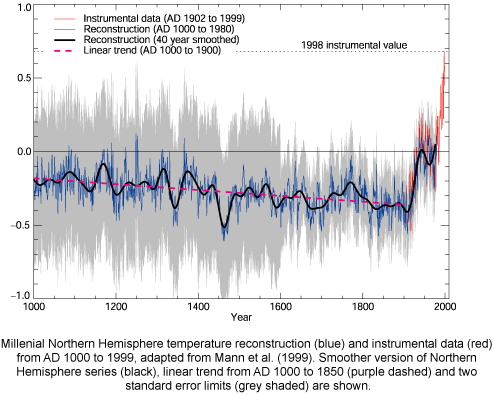
Truth and facts hold through time. Lies fade in the wind or die under the weight of truth.
“A Call to Judge Based on Relevant Facts and Assessment, Not the Odd Opinion” – Getting this right is pretty important considering all that is at stake and the cost of waiting. It’s about the economy and the costs in human terms. Let’s stop playing games by quoting random “scientists” and start asking the media to qualify statements from “scientists” by asking if the opinion was peer-reviewed. Also, any statement that contradicts a peer reviewed opinion should be published alongside with relevant peer reviewed perspectives, and so identified.
On March 13, 2007, the New York Times published an article entitled “From a Rapt Audience, a Call to Cool the Hype” written by William J. Broad. It is a classic example of the method and madness that surrounds the topic of Global Warming.
The degree and severity of obfuscation of the facts is only matched by the subtlety of the word crafting and the distinct lack of facts to back up the overall arguments. The article itself is dominated by its tone rather than fact; misleading at best, and ignorant and/or nefarious at worst.
Seemingly designed to diminish the integrity of Al Gore and the reality of Global Warming, the writer handily crafts his bias with context and characterization, as well as selective questioning and quote arrangement. It is very skillfully done, but with little integrity. The average reader would easily be misled by the presentation of doubt and narrow or conflicting data presented as authoritative. The “scientists” quoted toward the end of the article are mostly misleading, and/or wrong, stating opinion without reference or fact checking. This may be the choice of the writer, Broad?
Broad could have checked the facts himself with actual records at NOAA and NCDC climatologists, or just gone online and looked up the data on their web sites. Instead he chose less relevant opinions found to oppose peer reviewed scientific opinion.
Selective quote placement takes statements from Dr. James Hansen, and uses them to orchestrate the tone of the article, which seems to discount the peer reviewed relevant science perspectives; and Al Gore, as well as the documentary “An Inconvenient Truth”.
Tone is important. This article is a perfect example of just how misleading bias can be when skillfully applied by narrowly researched views or opinions.
There are intentional statements in the article to make it sound fair and balanced, by characterizing Mr. Gore with a tone of: he did an okay job, even though he was wrong on some things.
Unfortunately, it also characterizes the global warming argument falsely, and does no justice to the relevant science on the matter. The selective quoting method further obfuscates the message of the science and the intended message of Mr. Gore.
Mr. Broad’s lack of fact checking severely impairs the argument the article attempts to make. The New York Times could improve the integrity of such reports if they more strongly encouraged their reporters to check facts, and report facts, that are relationally pertinent to the opinions they are gathering.
The image below illustrates the reality of global warming rather well. You do not need to be a scientist to see that when we started burning fossil fuels and industrializing agricultural and production systems, a dramatic shift from the previous linear cooling trend occurred.

NOAA/NCDC (brief synopsis of the 2001 report by the IPCC – not updated to current)
How important are these changes in a longer-term context?
http://www.ncdc.noaa.gov/oa/climate/globalwarming.html#Q8
We don’t need to be alarmist just because the alarms are ringing. Instead, while the alarms are ringing, we need to be calm and think this through in order to conceive an effective plan to mitigate the amount of disruption to economic, geographic, agricultural, social, environmental, biologic and even military systems. We need to be real when it comes to understanding science and assessment.
When reporters use arguments by quoting “scientists” without qualifiers (such as peer reviewed, or expertise in global climatology), they do a disservice to their news organization, the people they are reporting to, and in this case, ultimately, to the world at large.
There are problems with the general label “scientist” as it is now being abused by many media and other organizations. Just because someone has the label scientist does not make them necessarily an expert in any given subject, and it certainly does not make them a climatologist that has a good read on the scope of the global warming picture.
The relevant science comes from peer-reviewed papers on the subject and those that are working on the larger scope of climate inter-dynamics and related factors (the big picture). Not just any “scientist” that examines narrowly scoped aspects and then tries to apply the limited findings to that larger climate picture. The majority of loosely written contradictions come from either non peer-reviewed papers, or sources that are not well versed in the aggregate of relevant facts, the relationships of the facts, and the inter-dynamics and trends; or, they may derive from definitive bias from systemic influences that are opposed to the science for reasons of profit.
Those that have expressed their peer-reviewed perspectives, on climate science are still not telling the whole developing story. The discussion of late has included the reticence to release certain information that is not yet fully vetted into a media maelstrom. This must then be weighed against the cost and risk of not releasing relevant trend analysis. That cost being the potential or likely affect on the human population, and earth as a system.
The consequences of waiting can be quite harmful to the economy and the earth environment. But the media is now playing a part in the quashing of relevant scientific opinion in favor of headline grabbers from disputing opinions that feed the controversy.
By not differentiating the contradictions and controversy from peer-reviewed facts and reasonable trend analysis, the media unwittingly becomes an accomplice in the affect they have on the progress of policy as it pertains to needs and mitigation. This in turn places the media in the odd position of increasing the negative potentials of global warming and increasing the human, economic and environmental costs. Said another way, the hot air from the media is now contributing to global warming by delaying the facts and well-vetted analysis, which impedes needed policy development to mitigate future costs.
The economic impacts have already begun. Hurricane Katrina was fed by warmer oceans, which caused a more intense storm. This is a fact, and this fact is linked, to the temperature of the water. Hurricanes Katrina and Rita were both associated with anomalously warm sea surface temperatures in the Gulf of Mexico (mostly Region 2*) during the month of August, in particular. Hurricane Wilma became a record-breaking third Category-5 hurricane of the season in October, in the wake of exceptionally high Sea Surface Temperature (SST) recorded in the Western Caribbean (Region 4; September plot).
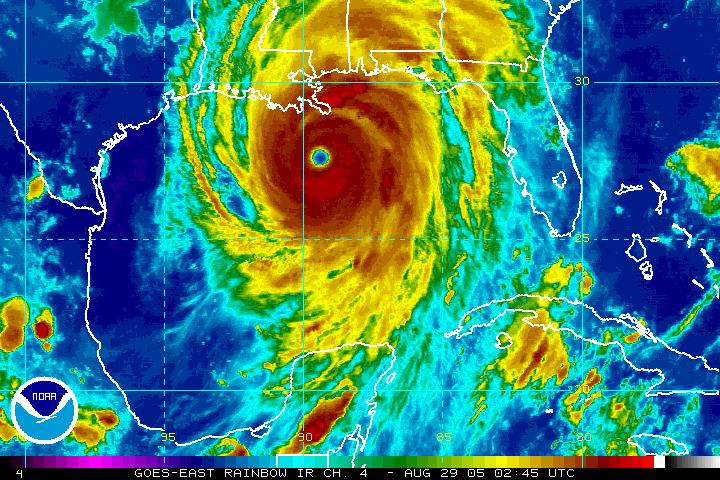
NOAA, Earth System Research Laboratory – Physical Systems Division
Historical Sea Surface Temperatures and Recent Hurricane Activity
http://www.cdc.noaa.gov/Hurricane/
While there is a possibility that this is a multi-decadal variability any reasonable analysis by any reasonable “non scientific person” given the facts in clear and concise terms, can come up with other potential or even more likely explanations based on the trends and current knowledge in the factual records.
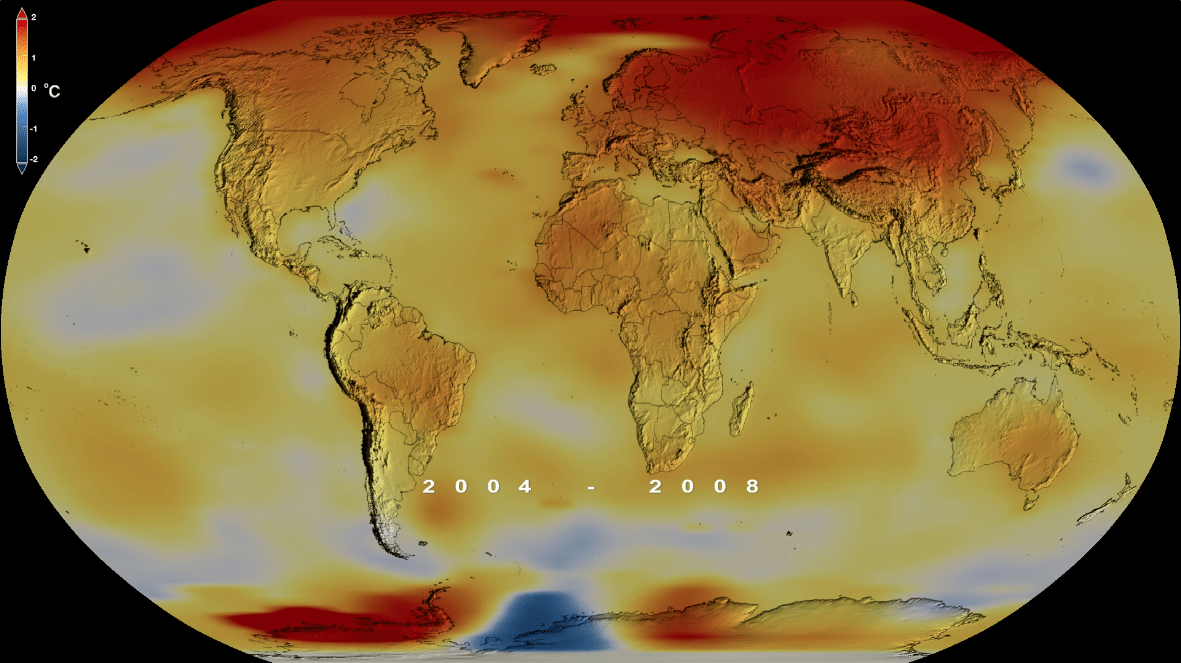
NOAA/NCDC (National Climate Data Center)
Global Surface Temperature Anomalies
http://www.ncdc.noaa.gov/oa/climate/research/anomalies/anomalies.html
It is clear in the image above that global warming is occurring and now the IPCC as well as US government Science directors have stated that this is human caused. It is clear by the image below that the White House is limiting data release for “climate related press releases”; therefore America is handicapped on policy relating to relevant data and assessment by the continued confusion between the White House and the relevant established scientific assessment.
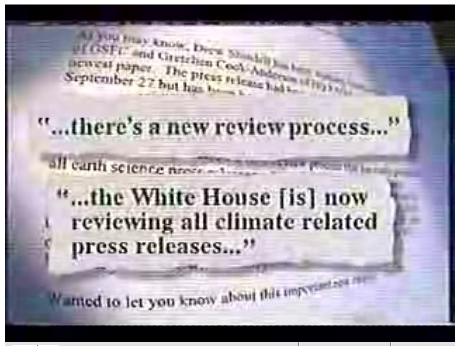
We need to start looking at the facts, not the opinions, and controversies stirred up in a media rich, oil dependent, and in many ways corrupted environment by the virtue of special interests inclined to hold profit above honor.
Media organizations sell more ads and commercials when they have controversy. Oil companies benefit from selling oil. Nuclear power companies benefit if we build new nuclear power plants. Clean and safe energy research is still on the backburner for the Bush administration despite the lip service given at press conferences.
It will take people a while to understand what it means, that inertial momentum has jumped from Co2 of 278 ppm (pre-industrial) to our current 382 ppm (increasing). Think of a freight train the size of planet earth, then the momentum gets a little perspective.
The media needs to stop looking for random scientific opinions that fuel controversy, and start showing the facts from data collected www.noaa.gov, http://www.ncdc.noaa.gov/oa/ncdc.html
Let the people assimilate the facts and peer reviewed perspectives. This means release more “data”, and less “opinions” from the less relevant sources. People and policy makers need to make informed decisions, but without a responsible media the public and policy makers continue to be handicapped.
We don’t have time to waste. The longer we wait, the more costly it will be. Stop entertaining just anyone with the label “Scientist” just because they oppose scientific facts. Why, because it is dishonest.
There are relevant sources that can speak on the science and trends observed, and reasonably portray potentials that should be considered in policy formation. Relevant sources should include those in the majority of peer-reviewed analysis on the subject of global warming. Other sources can be quoted, but there should be notation that their opinions had not been peer reviewed for proper perspective. There are 6.4 billion opinions in the world; that does not mean that we should believe all of them.
Do not be fooled, this is a mortgage that will be very difficult to afford.
COMMENTS ON RELEVANT EXCERPTS FROM THE BROAD ARTICLE:
Still, Dr. Hansen said, the former vice president’s work may hold “imperfections” and “technical flaws.” He pointed to hurricanes, an icon for Mr. Gore, who highlights the devastation of Hurricane Katrina and cites research suggesting that global warming will cause both storm frequency and deadliness to rise. Yet this past Atlantic season produced fewer hurricanes than forecasters predicted (five versus nine), and none that hit the United States.
Response: The drop in the number of hurricanes in the Atlantic resulted mainly due to the El Nino effect, which drew energy from the Atlantic to the Pacific where several of the largest storms on record were recorded The fact that there were such large storms in the pacific has been largely missed by the American press. Hurricane climatologists know that SST “Sea Surface temperature” affects hurricane intensity and Al Gore pointed this out in his movie.
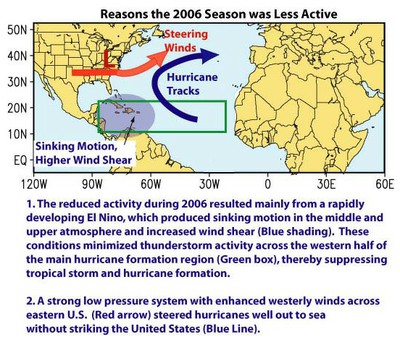
NOAA News
RETURN OF EL NIÑO YIELDS NEAR NORMAL 2006 ATLANTIC HURRICANE SEASON
http://www.noaanews.noaa.gov/stories2006/s2748.htm
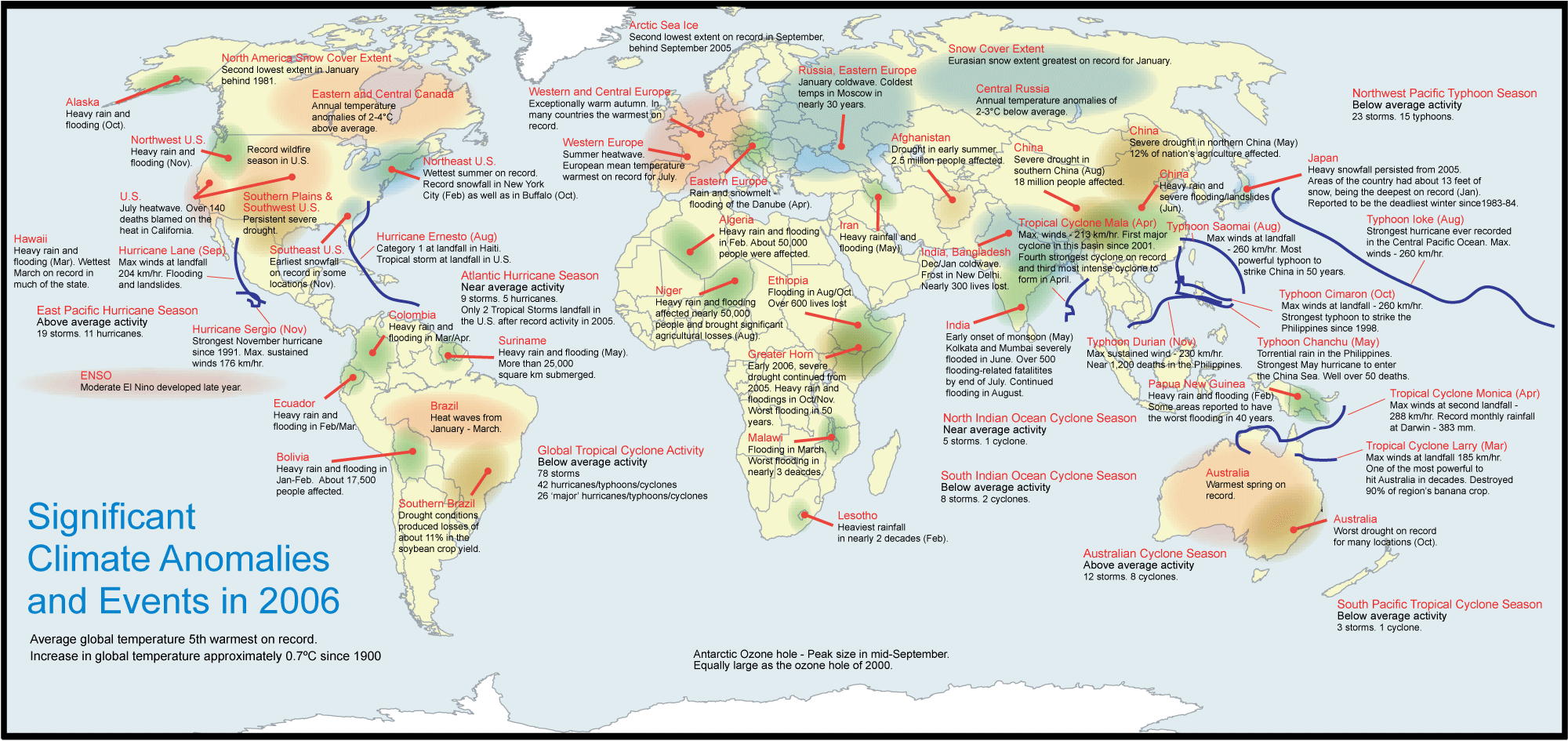
NOAA/NCDC (National Climate Data Center)
Climate of 2006 – in Historical Perspective
http://www.ncdc.noaa.gov/oa/climate/research/2006/ann/ann06.html
NOAA/NCDC
Climate of 2006 El Niño/Southern Oscillation (ENSO)
http://www.ncdc.noaa.gov/oa/climate/research/2006/enso-monitoring.html
It (IPCC) estimated that the world’s seas in this century would rise a maximum of 23 inches — down from earlier estimates. Mr. Gore, citing no particular time frame, envisions rises of up to 20 feet and depicts parts of New York, Florida and other heavily populated areas as sinking beneath the waves, implying, at least visually, that inundation is imminent.
Response: The IPCC reports are intentionally conservative in order to protect the integrity of the report. The lag dictates that the report will always be behind the leading edge of the research. It is estimated that the feedback loops that are in place will likely affect around 1 meter of sea level rise by 2100. Since the feedback loops are accelerating, actual rise may supercede current estimations. Human intervention may mitigate this likelihood.
So too, a report last June by the National Academies seemed to contradict Mr. Gore’s portrayal of recent temperatures as the highest in the past millennium. Instead, the report said, current highs appeared unrivaled since only 1600, the tail end of a temperature rise known as the medieval warm period.
Roy Spencer, a climatologist at the University of Alabama, Huntsville, said on a blog that Mr. Gore’s film did “indeed do a pretty good job of presenting the most dire scenarios.” But the June report, he added, shows “that all we really know is that we are warmer now than we were during the last 400 years.”
Response: The chart from NOAA/NCDC shows there was a gentle warming period between 800 and 1300, then cooling again. There was a small temperature spike around 1600 but it was only about .2 C and still below the temperature of the Medieval Warm Period, which is nowhere near the current mean temperature of earth’s atmosphere.
NOAA/NCDC (National Climate Data Center)
Climate Over Past Millennia (Past 1800 years)
http://www.ncdc.noaa.gov/paleo/pubs/jones2004/jones2004.html
Wikipedia
Medieval Warm Period
http://en.wikipedia.org/wiki/Medieval_warm_period
An Analysis of Roy Spencer’s argument, and testimony to Congress.
Was the Medieval Warm Period MWP warmer than today? Can a single measurement from the GRIP ice core be used to estimate the global average temperature? Is proxy data using multiple climate models better than raw data not corrected for variability, from a single source?
Was the global average temperature warmer during the medieval warm period? (Read the article)
The below chart was used by Spencer in his testimony to the Committee on Oversight and Government Reform on March 19, 2007(Link to PDF of Testimony)
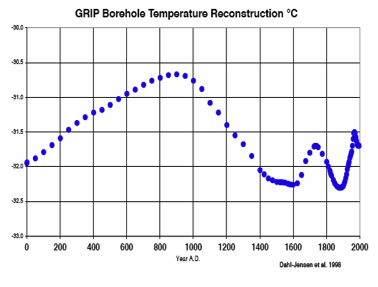
According to Spencer this chart is based on “The GRIP (Greenland) borehole temperature record is not a proxy, but a direct measure of temperature (Dahl-Jensen et al. 1998).”
Spencer states "there is no compelling evidence... in the last 1000 years" that the warming is "attributable to human GHG emissions". And also states that a June 06 NRC report "concluded with high confidence...that we are now the warmest in 400 years - not 1000 years." And "Greenland boreholes reveal the MWP to be warmer than today (See figure above)".
He implies that because it is not proxy data, it shows that the actual temperature of the planet was much higher in the MWP than it is today. What he is not saying is that this is the temperature in Greenland, and that micro-climate or regional variance, as well as subsurface and/or heat flux variations could influence the readings. Interpretation with regard to other measurements and their relationship with the global mean temperature (the larger the data set corrected for variations and interpolated between multiple models gives us the co-related data to see a global average temperature picture).
His argument can be compared to measurements taken on an urban heat island, or any particular region, and saying that that represents the global average temperature. It doesn’t work that way, You need to take measurements all over the place and then try and figure out any influences on the measurements and error potentials, and then correct for variability in the model. Another important consideration is that climate studies on the subject show that the polar regions experience Polar Amplification causing more warming than regions between the tropics. This is what allowed Greenland and Iceland to be more inhabitable during the MWP, which became, in that period, inhabited by viking colonies and allowed Lief Ericsson to discover America.
Note: While it was a little warmer during the MWP, it wasn't that warm
(Wikipedia Article) and the settlement eventually died away, seemingly
due to starvation. They arrived around 982 (peak of the MWP) and the
settlement lasted about 450 years ending after significant cooling
(see graph above). Apparently the cattle and sheep did not do well in
the climate.
On the AGU (American Geophysical Union) website there is a page that was published in the JOURNAL OF GEOPHYSICAL RESEARCH, VOL. 108, NO. B3, 2143 that explains the data collected in detail. From this, one can see why data needs to be modeled into proxy data to attempt a clearer picture.
Multiple models are applied in order to achieve a better picture of the data.
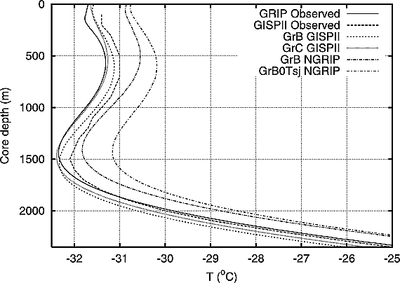
In Section 3 of Roy Spencer’s testimony: “The Science of Global Warming” one can see that, on a stand alone basis, it appears he is making a sound argument. But a closer look shows some problem areas.
One of the main problems in the global warming argument is bias of perspective. When ones own view of data is narrow, it becomes increasingly difficult and/or inappropriate to use that data to represent, with any realistic degree of accuracy, the big picture of the global average temperature.
Spencer is using GRIP ice core data to state that “globally averaged temperature” was warmer than today. He also states, “In summary, the evidence for today’s global warmth being unusual for interglacial conditions is neither extraordinary nor compelling.”
Spencer then impeaches “anthropogenic Co2 emissions” by saying, “this interpretation of ice core data is, at best, controversial.” And then states, “I believe that ice cores should not be used to promote any quantitative estimates of how much warming a given amount of extra carbon dioxide will “cause”.”
So, if, as he states, the ice core should not be used to promote quantitative estimates, then why is he using the ice core data to establish that it was warmer during the MWP than today (and implying that this warmer period was the global average, not just Greenland and the Ural Mountains)?
None of the proxy models I have seen on NOAA/NCDC sites show it being warmer in the MWP.
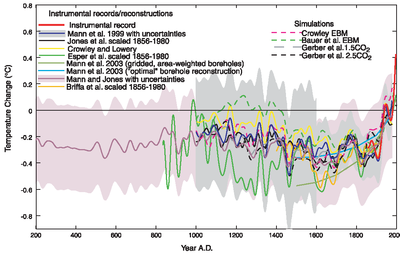
The chart above shows the proxy data from multiple sources and analysis adjusted for variations based on the models used. One can see that with regard to the global mean temperature, the current temperature is much higher than indicated by Spencer’s claims, and the graph he submitted in his testimony to congress.
Also, In Spencer’s testimony, he attributes the majority of climatologists are victims of “confirmation bias” stating :”Researchers tend to be more accepting of data that confirms their preconceived notions or political or societal predilections. After all, what scientist would not want to be the one to discover an impending environmental disaster that awaits humanity…to “save the Earth”?”
However, Spencer seems to be subject to, or victim of, that very same “confirmation bias” when he states “I would rather be the researcher who discovers that global warming will be relatively benign”.
End of Spencer Analysis
“Hardly a week goes by,” Dr. Peiser said, “without a new research paper that questions part or even some basics of climate change theory,” including some reports that offer alternatives to human activity for global warming.
Response: How many of these “scientific” opinions are peer reviewed?
Geologists have documented age upon age of climate swings, and some charge Mr. Gore with ignoring such rhythms.
Response: Mr. Gore’s movie did not ignore past climate change. Mr. Gore pointed out past climate swings and also showed their strong correlation to Co2 in the atmosphere. The causes of those Co2 increases are many. The cause of our current increase of Co2, methane and nitrous oxide is anthropogenic.
“Nowhere does Mr. Gore tell his audience that all of the phenomena that he describes fall within the natural range of environmental change on our planet,” Robert M. Carter, a marine geologist at James Cook University in Australia, said in a September blog. “Nor does he present any evidence that climate during the 20th century departed discernibly from its historical pattern of constant change.”
Response: While the statement is partially true, the context and connotation is far from the truth. True, this climate change is in the natural range as recorded history shows. It has been hotter and colder than present climate. The main difference is this is human caused, and many past dramatic climate changes occurred long before humans were around. One of those dramatic changes wiped out around 90 to 95% of all life on earth, marking the end of the Permian Period.
In October, Dr. Easterbrook made similar points at the geological society meeting in Philadelphia. He hotly disputed Mr. Gore’s claim that “our civilization has never experienced any environmental shift remotely similar to this” threatened change.
Response: The truth is that Al Gore was correct. Never before has a species on earth dug oil out of the ground and burned it, adding gigitons of Co2 to the atmosphere, an increase of 36% since pre-industrial age. Never before has an industrial based, oil fed, farming operation added an 18% increase of nitrous oxide and a 148% increase of methane. The human species is unique and Mr. Gore is absolutely correct in saying that “our civilization has never experienced any environmental shift remotely similar to this” regarding “THIS” climate change.
Nonsense, Dr. Easterbrook told the crowded session. He flashed a slide that showed temperature trends for the past 15,000 years. It highlighted 10 large swings, including the medieval warm period. These shifts, he said, were up to “20 times greater than the warming in the past century.”
Response: Dr. Easterbrook and Broad are again misleading the reader. The evidence on the NOAA and NCDC web sites show that global mean temperature during the period mentioned have not been higher than current temperatures. The last really big swing was 18,000 to 15,000 years ago coming out of the last ice age.
The current climate change is .76 C in the past century. 20 times that would be a temperature increase of 15.2 C. The way Easterbrook characterizes this could be easily misunderstood to mean that we have been 15.2 C warmer than where we are now. That would mean the temperature was as high as 28 C average mean global temperature. The hottest temperature known by geological assessments is around 8 C hotter. That was 530 million years ago though. Most life then was multi-cellular organisms and/or in forms as advanced as trilobite, according to studies.
If Dr. Easterbrook is referring to the temperature change coming out of the last ice age, then he is still incorrect as that was not a change of 15.2 C, it was more like a rise of 9 C in the global mean temperature. Data from Greenland ice core GISP2 indicates that the summit of Greenland was ~15 °C colder than today, so we need to understand and consider the temperature difference between variations in regional and micro-climates, compared to the global mean.
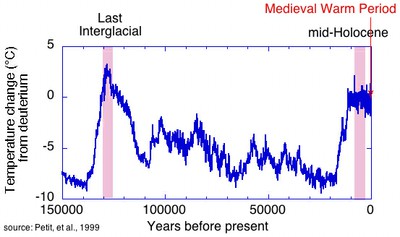
NOAA/NCDC (National Climate Data Center)
Deuterium Analysis – Paleoclimatic Data Before 2000 Years Ago
http://www.ncdc.noaa.gov/paleo/globalwarming/paleobefore.html
Wikipedia
Abrupt climate change – The Younger Dryas
http://en.wikipedia.org/wiki/Younger_Dryas#Abrupt_climate_change
The following study indicates the Ice Age temperature 6 C less than today’s global mean temperature.
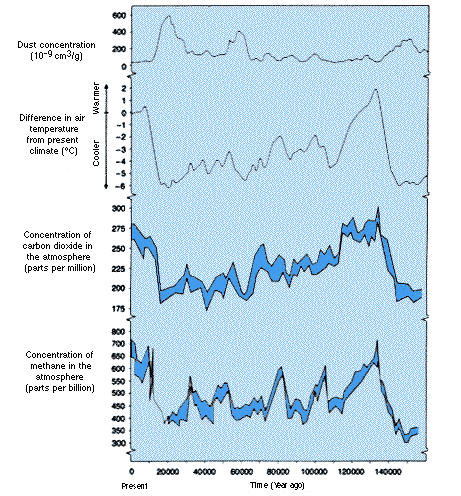
University of Wyoming Atmospheric Science
Ice cores, CO2 concentration, and climate
http://www-das.uwyo.edu/~geerts/cwx/notes/chap01/icecore.html
Getting personal, he mocked Mr. Gore’s assertion that scientists agreed on global warming except those industry had corrupted. “I’ve never been paid a nickel by an oil company,” Dr. Easterbrook told the group. “And I’m not a Republican.”
Response: Since he is not being paid, we are left to wonder why Dr. Easterbrook has chosen to represent inaccuracies as facts, as illustrated on the US government web sites. NOAA (National Oceanographic and Atmospheric Administration) and NCDC (National Climate Data Center)?
Biologists, too, have gotten into the act. In January, Paul Reiter, an active skeptic of global warming’s effects and director of the insects and infectious diseases unit of the Pasteur Institute in Paris, faulted Mr. Gore for his portrayal of global warming as spreading malaria.
“For 12 years, my colleagues and I have protested against the unsubstantiated claims,” Dr. Reiter wrote in The International Herald Tribune. “We have done the studies and challenged the alarmists, but they continue to ignore the facts.”
Response: In the paper Paul Reiter wrote “Climate Change and Mosquito-Borne Disease” Reiter explains in his abstract “Elementary models suggest that higher global temperatures will enhance their transmission rates and extend their geographic ranges.” He then says “However, the histories of three such diseases–malaria, yellow fever, and dengue–reveal that climate has rarely been the principal determinant of their prevalence or range; human activities and their impact on local ecology have generally been much more significant. It is therefore inappropriate to use climate-based models to predict future prevalence.”
Environmental Health Perspectives Supplements Volume 109, Number S1, March 2001
Climate Change and Mosquito-Borne Disease
http://www.ehponline.org/members/2001/suppl-1/141-161reiter/reiter-full.html
This is a contradiction. We already know that: warming is happening and is human caused. He states that models suggest higher temperature will enhance transmission; and then he states, “It is inappropriate to use climate based models to predict future prevalence.”
Global warming puts more moisture in the air, albeit regionally dispersed depending on changing momentums. In those areas where moisture increases and gathers, there will be more mosquito’s and therefore more “Mosquito-Bourne Disease”; Hence Reiter’s statement, “Elementary models suggest that higher global temperatures will enhance their transmission rates and extend their geographic ranges.”
Paul Reiter is not a climate expert as it pertains to Global Warming. He is an expert in insects and infectious diseases. Context of an argument is important to understand its relevance.
I am not a scientist. But does one need to be a scientist to understand the obvious when given sufficient information. In fact, most people are not scientists, but we do need to understand global warming and its causes, because this is affecting the planet and we are causing this climate forcing.
The quandary regular people face is that we don’t have the time to study all this. So we need to rely on scientific assessment to get the facts right, and the media to report the facts as facts and the conjectures and opinions as just that, conjectures and opinions. The media has the responsibility to clarify not obfuscate the issues, as that influences the people, and will thereby influence policy makers as driven by the voters. We need to get this right. Sure we might be mistaken in our understanding on interpretation once in a while along the way, but as long as we are willing to learn, we will figure this out. Hopefully in time to avert larger alarms than we already are seeing.
Unite America with The Centrist Party
- Enough is enough. We must unite to reclaim our government. Join the Centrist Party. Work together to heal our nation and return balance in governance and common sense for the nation and the people.
The Centrist News
Check out Centrist News & Perspectives for centrist media intelligence:
Recent Comments